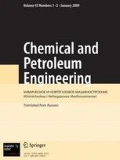Synthesis of a mathematical model of cooling of supercharging gas in the vapor space of cryogenic tanks containing liquefied gas is studied. Based on the model of a unidimensional dynamic thermal boundary layer, it is shown that the heat flux through the free liquid hydrogen surface in the cryogenic tank having a vapor space supercharged with gaseous hydrogen is much less than the heat flux through a wetted surface. The operational process of supercharging vapor space with gaseous hydrogen is studied by the example of a commercial liquid hydrogen tank. An example of calculation that shows the procedure of calculation of specific heat fluxes is given. The calculation results show that in the working range of fractions of the vapor space the heat flux through the liquid surface is much less than the heat flux through a wetted surface and that the heat of the supercharging gas exerts practically no influence on the change in temperature of the cryogenic liquid during its storage in the tank.



Similar content being viewed by others
References
V. P. Belyakov, Cryogenic Engineering and Technology, Energoizdat, Moscow (1982).
V. V. Biryuk and A. V. Smorodin, “Use of vortex energy separator for optimizing supercharging of tanks,” Vestn. Samar. Gos. Aerokosm. Univ., No. 3 (19), 40–44 (2009).
A. M. Domashenko, V. N. Krishtal, M. V. Krasovitskii, et al., “Building and improving cryogenic fi lling and testing space rocket engineering complexes,” Tekhn. Gazy, No. 1, 27–30 (2009).
N. M. Belyaev and A. A. Ryadno, Methods of the Theory of Thermal Conductivity, Pt. 1, Vysshaya Shkola, Moscow (1982).
G. Korn and T. Korn, A Handbook of Mathematics for Scientific Workers and Engineers [Russian translation], Nauka, Moscow (1973).
A. V. Lykov, Heat and Mass Exchange: Handbook, Energiya, Moscow (1978).
N. V. Filin and A. B. Bulanov, Liquid Cryogenic Systems, Mashinostroenie, Leningrad (1985).
D. Yu. Gamburg and N. F Dubovkin (eds.), Hydrogen: Properties, Production, Storage, Transportation, and Use, Khimiya, Moscow (1989).
M. P. Malkov (ed.), Liquid Hydrogen, Mir, Moscow (1964).
Author information
Authors and Affiliations
Corresponding author
Additional information
Translated from Khimicheskoe i Neftegazovoe Mashinostroenie, No. 2, pp. 22–23, February, 2017.
Rights and permissions
About this article
Cite this article
Ryazhskikh, V.I., Khvostov, A.A., Ryazhskikh, A.V. et al. Estimation of Heat Flux Through Free Liquid Hydrogen Surface in Cryogenic Tanks with Supercharged Vapor Space. Chem Petrol Eng 53, 101–105 (2017). https://doi.org/10.1007/s10556-017-0302-1
Published:
Issue Date:
DOI: https://doi.org/10.1007/s10556-017-0302-1




